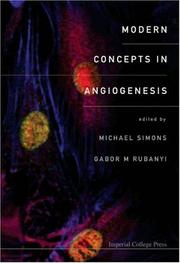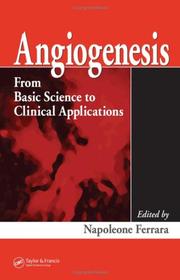| Listing 1 - 10 of 12 | << page >> |
Sort by
|
Book
ISBN: 9175190796 Year: 2015 Publisher: Linköping, Sweden : Linköping University,
Abstract | Keywords | Export | Availability | Bookmark
 Loading...
Loading...Choose an application
- Reference Manager
- EndNote
- RefWorks (Direct export to RefWorks)
Neovascularization. --- Vascular endothelial growth factors.
Book
Year: 2011 Publisher: Bruxelles: UCL,
Abstract | Keywords | Export | Availability | Bookmark
 Loading...
Loading...Choose an application
- Reference Manager
- EndNote
- RefWorks (Direct export to RefWorks)
bevacizumab --- Vascular Endothelial Growth Factors --- Neoplasms

ISBN: 1281867543 9786611867546 1860949452 9781860949456 9781281867544 9781860947636 1860947638 6611867546 Year: 2007 Publisher: London : Hackensack, NJ : Imperial College Press ; Distributed by World Scientific Pub.,
Abstract | Keywords | Export | Availability | Bookmark
 Loading...
Loading...Choose an application
- Reference Manager
- EndNote
- RefWorks (Direct export to RefWorks)
"This volume addresses current emerging concepts in the field of angiogenesis, including important angiogenesis modifiers which are essential in combination with growth factors (VEGF and FGF) for the physiological process and also for therapeutic applications. It covers many of the lesser discussed areas including blood vessel growth guidance (interactions with CNS) as well as emerging practical applications of these concepts. The book comprises in-depth reviews by leading experts in several major areas: recent basic science discoveries about angiogenesis modifiers (semaphorins, ephrins and nitric oxide, for which the Nobel Prize was awarded); arterial guidance; clinical applications of new angiogenic factors (HGF, HIF and eNOS); and basic and clinical advancement of anti-angiogenic molecules for the treatment of cancer and macular degeneration (tyrosine kinase inhibitors and NO). These topics, especially their unique combination presented in this volume, are not found in any other current books on angiogenesis. This makes the book a must-read for readers both interested and actively involved in the most recent advances in basic principles and clinical applications of angiogenesis."
Neovascularization. --- Vascular endothelial growth factors. --- Vascular endothelial growth factors --- Neovascularization inhibitors. --- Angiogenesis inhibitors --- Tumor angiogenesis inhibitors --- Antineoplastic agents --- Angiogenic factors --- Angiogenic proteins --- Endothelial growth factors, Vascular --- VEGFs (Proteins) --- Growth factors --- Blood-vessels --- Therapeutic use. --- Growth
Book
ISBN: 2742013393 9782742013395 9782742008216 Year: 2012 Publisher: Montrouge, France ; Esher, England : John Libbey Eurotext,
Abstract | Keywords | Export | Availability | Bookmark
 Loading...
Loading...Choose an application
- Reference Manager
- EndNote
- RefWorks (Direct export to RefWorks)
Book
ISBN: 1281927139 9786611927134 0387786325 0387786317 1441926933 Year: 2008 Publisher: Austin, Tex. : New York : Landes Bioscience/Eurekah.com ; Springer Science+Business Media,
Abstract | Keywords | Export | Availability | Bookmark
 Loading...
Loading...Choose an application
- Reference Manager
- EndNote
- RefWorks (Direct export to RefWorks)
This book is devoted to vascular endothelial growth factor A (VEGF or VEGFA), a secreted signalling protein of great significance for development and disease in vertebrates. VEGFA controls the proliferation, migration, specialisation and survival of vascular endothelial cells, and it is therefore essential for the establishment of a functional blood vessel circuit. In addition, VEGFA is emerging as a versatile patterning factor for several non-endothelial cell types in vertebrates. Thus, it plays a central role during organ development at multiple levels, including blood vessel growth, vessel-
Neovascularization. --- Vascular endothelial growth factors. --- Angiogenic factors --- Angiogenic proteins --- Endothelial growth factors, Vascular --- VEGFs (Proteins) --- Growth factors --- Angiogenesis --- Blood-vessels --- Growth --- Biochemistry. --- Biochemistry, general. --- Biological chemistry --- Chemical composition of organisms --- Organisms --- Physiological chemistry --- Biology --- Chemistry --- Medical sciences --- Composition

ISBN: 0849328446 9780849328442 9780429129537 Year: 2007 Publisher: Boca Raton: CRC,
Abstract | Keywords | Export | Availability | Bookmark
 Loading...
Loading...Choose an application
- Reference Manager
- EndNote
- RefWorks (Direct export to RefWorks)
Blood-vessels --- Vascular Endothelial Growth Factors --- Angiogenesis Modulating Agents --- Clinical Trials as Topic --- Neoplasms --- Neovascularization, Pathologic --- Neovascularization, Physiologic --- Growth --- therapeutic use --- pathology --- Vascular Endothelial Growth Factors. --- Clinical Trials as Topic. --- Neovascularization, Pathologic. --- Neovascularization, Physiologic. --- Clinical Trial as Topic --- Clinical Protocols --- Drug Evaluation --- Drugs, Investigational --- Clinical Trials Data Monitoring Committees --- Therapies, Investigational --- VEGFs --- Angiogenesis, Physiological --- Neovascularization, Physiological --- Physiologic Angiogenesis --- Physiologic Neovascularization --- Angiogenesis, Physiologic --- Physiological Angiogenesis --- Physiological Neovascularization --- Collateral Circulation --- Vascular Remodeling --- Angiogenesis, Pathological --- Neovascularization, Pathological --- Pathologic Angiogenesis --- Pathologic Neovascularization --- Angiogenesis, Pathologic --- Pathological Angiogenesis --- Pathological Neovascularization --- therapeutic use. --- pathology. --- Angiogenesis --- Blood-vessels - Growth --- Angiogenesis Modulating Agents - therapeutic use --- Neoplasms - pathology --- VASCULAR ENDOTHELIAL GROWTH FACTORS --- ANGIOGENESIS MODULATING AGENTS --- CLINICAL TRIALS --- NEOPLASMS --- NEOVASCULARIZATION, PATHOLOGIC --- NEOVASCULARIZATION, PHYSIOLOGIC --- THERAPEUTIC USE --- PATHOLOGY
Book
Year: 2021 Publisher: Basel, Switzerland MDPI - Multidisciplinary Digital Publishing Institute
Abstract | Keywords | Export | Availability | Bookmark
 Loading...
Loading...Choose an application
- Reference Manager
- EndNote
- RefWorks (Direct export to RefWorks)
In the two last decades, proteases have constituted one of the primary and important targets in drug discovery. The U.S. FDA has approved more than 12 protease therapies in the last 10 years, and a number of next-generation or completely new proteases are under clinical development. Protease inhibition strategies are one of the fastest expanding areas in the field of of drugs that show considerable promise. This Special Issue will focus on the recent advances in the discovery and development of protease inhibitors, covering the synthesis of protease inhibitors, the design of new chemical entities acting as inhibitors of special/particular types of proteases, and their mode of actions (Frolova et al. 2020; Slapak et al. 2020; Künnapuu et al. 2021). In addition, the new applications of these interesting compounds/biomolecules and their limitations have been discussed and described (Wang et al. 2020; Bartošová-Sojková et al. 2021).
Research & information: general --- MMP --- MMP2 --- MMP9 --- MMP7 --- MMP14 --- matrix metalloproteases --- PDAC --- pancreatic cancer --- Bowman–Birk inhibitor --- ranacyclin --- trypsin inhibitor --- structure–activity relationship --- synergistic effect --- Gentamicin --- matrix metalloproteinase --- extracellular matrix --- nuclei --- cancer --- apoptosis --- immune response --- cysteine protease inhibitor --- stefin --- signal peptide --- parasite --- phylogenetic analysis --- diversification --- protein structure --- vascular endothelial growth factors (VEGFs) --- VEGF-A --- PlGF --- VEGF-B --- VEGF-C --- VEGF-D --- angiogenesis --- lymphangiogenesis --- CCBE1 --- proteases --- ADAMTS3 --- plasmin --- cathepsin D --- KLK3 --- prostate-specific antigen (PSA) --- thrombin --- wound healing --- metastasis --- proteolytic activation --- vascular biology --- lymphedema
Book
Year: 2021 Publisher: Basel, Switzerland MDPI - Multidisciplinary Digital Publishing Institute
Abstract | Keywords | Export | Availability | Bookmark
 Loading...
Loading...Choose an application
- Reference Manager
- EndNote
- RefWorks (Direct export to RefWorks)
In the two last decades, proteases have constituted one of the primary and important targets in drug discovery. The U.S. FDA has approved more than 12 protease therapies in the last 10 years, and a number of next-generation or completely new proteases are under clinical development. Protease inhibition strategies are one of the fastest expanding areas in the field of of drugs that show considerable promise. This Special Issue will focus on the recent advances in the discovery and development of protease inhibitors, covering the synthesis of protease inhibitors, the design of new chemical entities acting as inhibitors of special/particular types of proteases, and their mode of actions (Frolova et al. 2020; Slapak et al. 2020; Künnapuu et al. 2021). In addition, the new applications of these interesting compounds/biomolecules and their limitations have been discussed and described (Wang et al. 2020; Bartošová-Sojková et al. 2021).
MMP --- MMP2 --- MMP9 --- MMP7 --- MMP14 --- matrix metalloproteases --- PDAC --- pancreatic cancer --- Bowman–Birk inhibitor --- ranacyclin --- trypsin inhibitor --- structure–activity relationship --- synergistic effect --- Gentamicin --- matrix metalloproteinase --- extracellular matrix --- nuclei --- cancer --- apoptosis --- immune response --- cysteine protease inhibitor --- stefin --- signal peptide --- parasite --- phylogenetic analysis --- diversification --- protein structure --- vascular endothelial growth factors (VEGFs) --- VEGF-A --- PlGF --- VEGF-B --- VEGF-C --- VEGF-D --- angiogenesis --- lymphangiogenesis --- CCBE1 --- proteases --- ADAMTS3 --- plasmin --- cathepsin D --- KLK3 --- prostate-specific antigen (PSA) --- thrombin --- wound healing --- metastasis --- proteolytic activation --- vascular biology --- lymphedema
Book
Year: 2021 Publisher: Basel, Switzerland MDPI - Multidisciplinary Digital Publishing Institute
Abstract | Keywords | Export | Availability | Bookmark
 Loading...
Loading...Choose an application
- Reference Manager
- EndNote
- RefWorks (Direct export to RefWorks)
In the two last decades, proteases have constituted one of the primary and important targets in drug discovery. The U.S. FDA has approved more than 12 protease therapies in the last 10 years, and a number of next-generation or completely new proteases are under clinical development. Protease inhibition strategies are one of the fastest expanding areas in the field of of drugs that show considerable promise. This Special Issue will focus on the recent advances in the discovery and development of protease inhibitors, covering the synthesis of protease inhibitors, the design of new chemical entities acting as inhibitors of special/particular types of proteases, and their mode of actions (Frolova et al. 2020; Slapak et al. 2020; Künnapuu et al. 2021). In addition, the new applications of these interesting compounds/biomolecules and their limitations have been discussed and described (Wang et al. 2020; Bartošová-Sojková et al. 2021).
Research & information: general --- MMP --- MMP2 --- MMP9 --- MMP7 --- MMP14 --- matrix metalloproteases --- PDAC --- pancreatic cancer --- Bowman–Birk inhibitor --- ranacyclin --- trypsin inhibitor --- structure–activity relationship --- synergistic effect --- Gentamicin --- matrix metalloproteinase --- extracellular matrix --- nuclei --- cancer --- apoptosis --- immune response --- cysteine protease inhibitor --- stefin --- signal peptide --- parasite --- phylogenetic analysis --- diversification --- protein structure --- vascular endothelial growth factors (VEGFs) --- VEGF-A --- PlGF --- VEGF-B --- VEGF-C --- VEGF-D --- angiogenesis --- lymphangiogenesis --- CCBE1 --- proteases --- ADAMTS3 --- plasmin --- cathepsin D --- KLK3 --- prostate-specific antigen (PSA) --- thrombin --- wound healing --- metastasis --- proteolytic activation --- vascular biology --- lymphedema
Book
Year: 2010 Publisher: [Place of publication not identified] Mary Ann Liebert
Abstract | Keywords | Export | Availability | Bookmark
 Loading...
Loading...Choose an application
- Reference Manager
- EndNote
- RefWorks (Direct export to RefWorks)
Neovascularization --- Tissue engineering --- Angiogenic Proteins --- Cardiovascular Physiological Processes --- Culture Techniques --- Publication Formats --- Intercellular Signaling Peptides and Proteins --- Cardiovascular Physiological Phenomena --- Clinical Laboratory Techniques --- Publication Characteristics --- Investigative Techniques --- Circulatory and Respiratory Physiological Phenomena --- Biological Factors --- Peptides --- Proteins --- Amino Acids, Peptides, and Proteins --- Analytical, Diagnostic and Therapeutic Techniques and Equipment --- Phenomena and Processes --- Chemicals and Drugs --- Tissue Engineering --- Vascular Endothelial Growth Factors --- Neovascularization, Physiologic --- Collected Works --- Human Anatomy & Physiology --- Health & Biological Sciences --- Physiology
| Listing 1 - 10 of 12 | << page >> |
Sort by
|

 Search
Search Feedback
Feedback About UniCat
About UniCat  Help
Help News
News